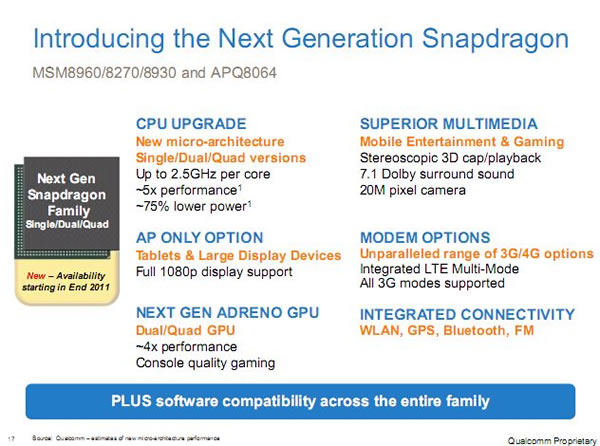MobileTechWorld has stumbled upon an internal presentation detailing Qualcomm's upcoming system-on-a-chip technology. Based on the new Krait architecture, the MSM8270, MSM8930, MSM8960, and APQ8064 Snapdragon chips are expected to sample this year with the 3G/LTE MSM8960 landing in the hands of Qualcomm's partners this quarter and the rest arriving toward the end of 2011. The SoCs will be available with a single, dual or quad-core CPU clocked up to 2.5GHz along with a dual or quad-core GPU.
According to the leaked slides, the next-generation processor will offer up to five times the performance of existing Snapdragon chips while consuming 75% less power. Although the graphics portion of the chip is said to be a next-gen Adreno GPU, there's no specific mention of an Adreno 3xx. That leaves MobileTechWorld to speculate that it's possibly an Adreno 22x. Regardless, Qualcomm claims the graphics performance will improve fourfold, delivering "console quality gaming" and support for 1080p displays.

The upcoming parts will also provide support for 7.1 Dolby surround sound, stereoscopic 3D capture and playback, a 20-megapixel camera, as well as embedded multi-mode LTE, 3G, WLAN, GPS, Bluetooth and FM connectivity. One of the slides offered a forward-looking performance comparison between the next-gen Snapdragon and the competing Cortex-A15 SoC, as well as the dated A9 chip. Qualcomm expects to deliver up to 23% more performance than the A15 while consuming 47% less power at the same speed.
https://www.techspot.com/news/43494-qualcomm-new-snapdragon-is-23-faster-than-cortex-a15.html